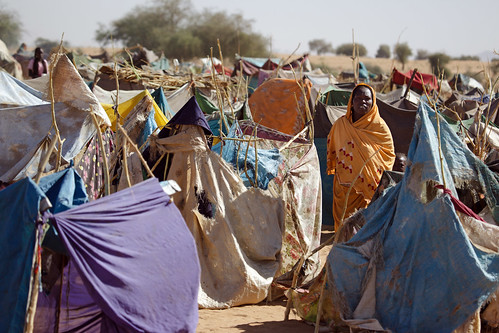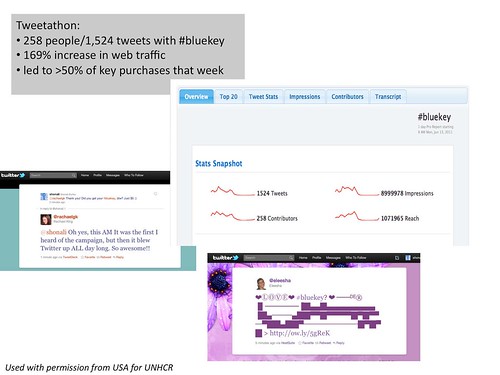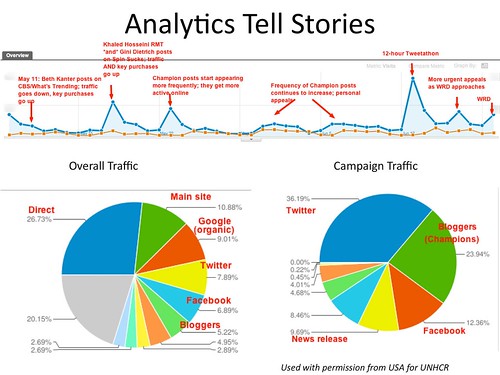
Note from Beth: Last May, USA for UNHCR launched The Blue Key campaign as a way for U.S. residents to show their support for the 43 million refugees around the world leading up to World Refugee Day on June 20th. I was honored when Shonali Burke invited me to be a Blue Key Champion. She set up a private Facebook Group to facilitate our support for the campaign. A few weeks ago, she reported back to the group some of the results of our work with some insights based on Google Analytics charts. Shonali kindly agreed to an interview to share this story more broadly.
1. What’s elevator speech for the organization, he campaign and your role.
USA for UNHCR (my client) is a 501(c)(3) headquartered in Washington, D.C. They raise funds and awareness in the United States for the lifesaving work that more than 6,000 staffers of Geneva-based UNHCR undertake for refugees around the world, 24/7. Given that there are more than 43.3 million refugees worldwide, this is pretty important work… and did I mention lifesaving? (Just look at what’s happening in Somalia right now.) The challenge is that typically refugees are so far removed from our “normal” lives that we don’t automatically think of giving to organizations that work to support them.
USA for UNHCR created the Blue Key campaign as a way to drive awareness of this global issue in the US. The $5 blue key pin or pendant symbolizes the one thing most of us have and that refugees don’t: a key to their own home.
My role is to work with USA for UNHCR on building out the digital and social media aspects of the campaign, particularly from an online community-building point of view. That is where the Blue Key Champion strategy came in; to bring on board US-based bloggers who are active online, and cause-passionate, to help spread the word and, hopefully, get more keys ordered.
2. What were the specific goals and KPIs for the campaign (assuming web traffic and key purchases?) Why important?
The Blue Key site was only launched in December 2010, and its social/digital aspects were relatively new, so there was not a lot of data to base KPIs on. Overall, when we went into the first phase of the campaign, we had two goals: to secure at least three Blue Key Champions, and to get 6,000 keys ordered between May 9 and June 20 (World Refugee Day).
These goals were important to USA for UNHCR first, because the entire Blue Key campaign revolves around more people purchasing keys, and second, because with a limited budget for traditional outreach, we relied on willing bloggers to help us get the word out.

3. Describe the Twitter Charts: What are you showing? What tool did you use? How do you know that Twitter caused the increase in Web site traffic? Any advice about setting up systems to track Twitter. Did you use any “real time” tracking of your tweets and make any adjustments along the way?
The Twitter chart looks at the impact of a “tweetathon” we decided to hold on June 13; one week before World Refugee Day (June 20). Several Champions signed up to “staff” tweeting about the refugee crisis and #bluekey (the campaign hashtag) from 9 a.m. – 9 p.m. ET that day, in shifts. In addition, Roya Hosseini, who manages the Khaled Hosseini Foundation’s Twitter account, signed on as a “special guest” between 1 & 2 p.m. (Khaled Hosseini is the author of The Kite Runner.)
We used Hashtracking (which was offered to me as a free trial for testing purposes) to pull data on how many tweets used the hashtag, etc. In addition, we track key purchases on a weekly basis (Tuesday through Monday). We had some Champion posts run that day as well.
All told, there was a 169% increase in web traffic that day, compared to the previous high point a few weeks prior. We get real time confirmations every time someone orders a key, so we knew it was working. Finally, via campaign URLs in Google Analytics, we saw that Twitter was the main driver of traffic (for May 9 – June 20). This was not the case before the tweetathon.
In terms of real time tracking, we paid attention to what was getting retweeted during the tweetathon, and the kinds of tweets that got responses. Periodically, we would post to the Blue Key Champions Facebook Group (a closed group set up to communicate with the Champions in real time) as to what we were seeing, so that those who were about to sign on for their shift could adjust their tweets accordingly if they wanted.
In terms of setting up systems to track Twitter, you need to identify what exactly it is that you’re trying to track, and why. There are several tools that do this, with RowFeeder and Hashtracking being two affordable ones. But I think it’s also important to track the outcomes you’re trying achieve, and then correlate everything that’s happening. So it’s not just a question of tracking tweets or retweets; you probably have to track several things simultaneously, in order to get the most pertinent information that will benefit your campaign.

4. Describe the Google Analytics Charts – specifically the diagram where you have annotations. What is the blue line? Orange line? Who did you prepare the chart for and why? What decisions or tweaks did you make to the campaign?
The Google Analytics chart looks at web traffic and trends between May 9 and June 20; the first phase of the campaign. The blue line shows the traffic highs and lows during that time period, and the orange line shows traffic for the previous six weeks.
To prepare the chart, I looked at not just the traffic, but also what activities we had engaged in during that time. I was able to do this by reviewing the campaign activity (Champion posts, a radio media tour that Khaled Hosseini had done for USA for UNHCR, the tweetathon, etc.) and ongoing reports of key purchases. Then I annotated the chart accordingly.
Both my client and I were curious about what exactly was working (and what was not), so they gave me the green light to create these charts (everyone should be so lucky!). Information is one thing; but if you’re not going to draw conclusions from it, it’s not very useful. So we wanted as much information as possible, for internal dissemination, to share with the Champions, as well as to share in general (for example, this interview), that might help others with their work as well.
When we saw how well the tweetathon had worked, we decided to include it in the next phase of the campaign. So we will be doing two more tweetathons; on September 21 and December 12. We’re continuing to bring more Champions on board, since their posts really helped spread awareness of the campaign, as well as bring the Blue Key site higher in Google searches.
5. Any practical tips or suggestions in setting up and doing this tracking?
A few things, especially for those on a small budget:
- If you’re not already using Google Analytics, set it up immediately, and start looking at it on a regular basis. Analytics really do tell stories!
- As I mentioned earlier, identify what you’re trying to achieve, and then decide what tools you’ll use to track progress towards/away from that goal.
- If you’re going to use campaign URLs, set them up in advance of the campaign, and then use them consistently through the campaign period.
- If you’re using a Champion approach, as we are, communicate the status and progress of the campaign regularly. That will help to keep them energized, which all helps in getting you closer to achieving your end goals.
- Don’t feel as if you have to measure everything; measure what’s most important to achieving the outcomes you desire.
6. What else did you measure and why? Based on review of the data, what will you do differently with the campaign?
We don’t have a big budget for measurement, so we’re focusing on key purchases and spreading awareness through the Champions and any resultant media/blog visibility. As it came to deciding the goals for this current phase of the campaign, we realized that 6,000 keys in 6 weeks (phase I) was a very ambitious goal. So now the goal is to get 6,000 keys out through Dec. 31, which we based on the number of keys purchased in the first phase of the campaign. I’m very proud of my client for being willing to review and change the goal based on data; there are a lot of organizations that wouldn’t do that.
We are also focusing on bringing on as many Champions as possible as we move ahead, and more quickly than we did during the last phase (we had around 40 Champions during Phase I). There is strength in numbers!
We’re starting to receive requests from other cause-passionate people to incorporate the Blue Key campaign into initiatives they are working on. As much as possible, we’re trying to move these forward, and we’re also hoping to take the Blue Key campaign offline via tweetups organized by Champions.
The Blue Key is a great conversation starter, as many of our Champions have noted when they wear them, and the more we can get people talking about it, the better our chances of reaching not just the “key” goal, but of truly shedding light and building a community of support for those who need it most – refugees.

Shonali Burke runs an agency of one and is adjunct faculty at Johns Hopkins University. Considered one of “25 women that rock social media,” she blogs at Waxing UnLyrical.

Leave a Reply